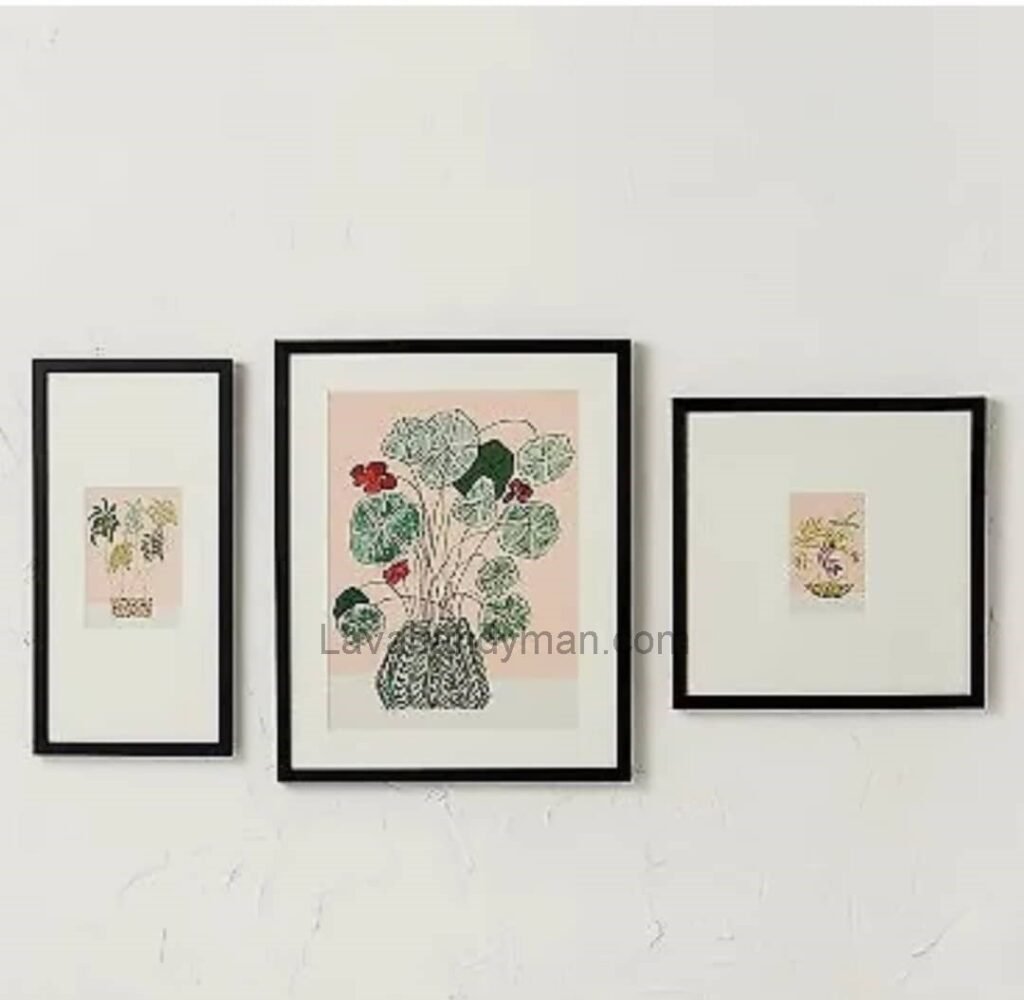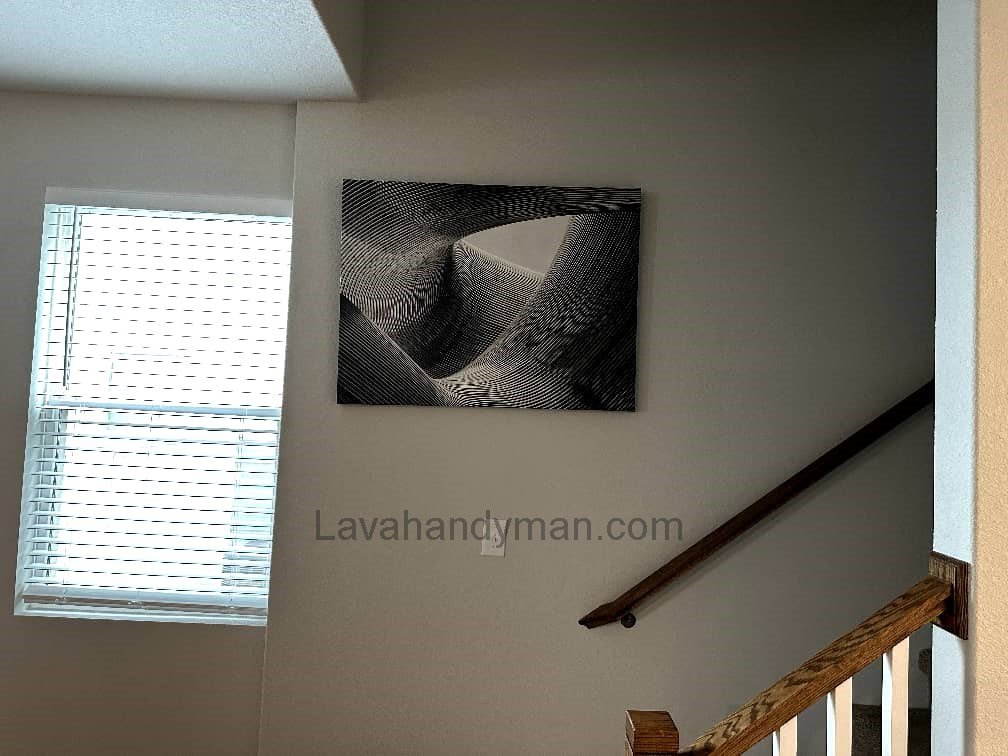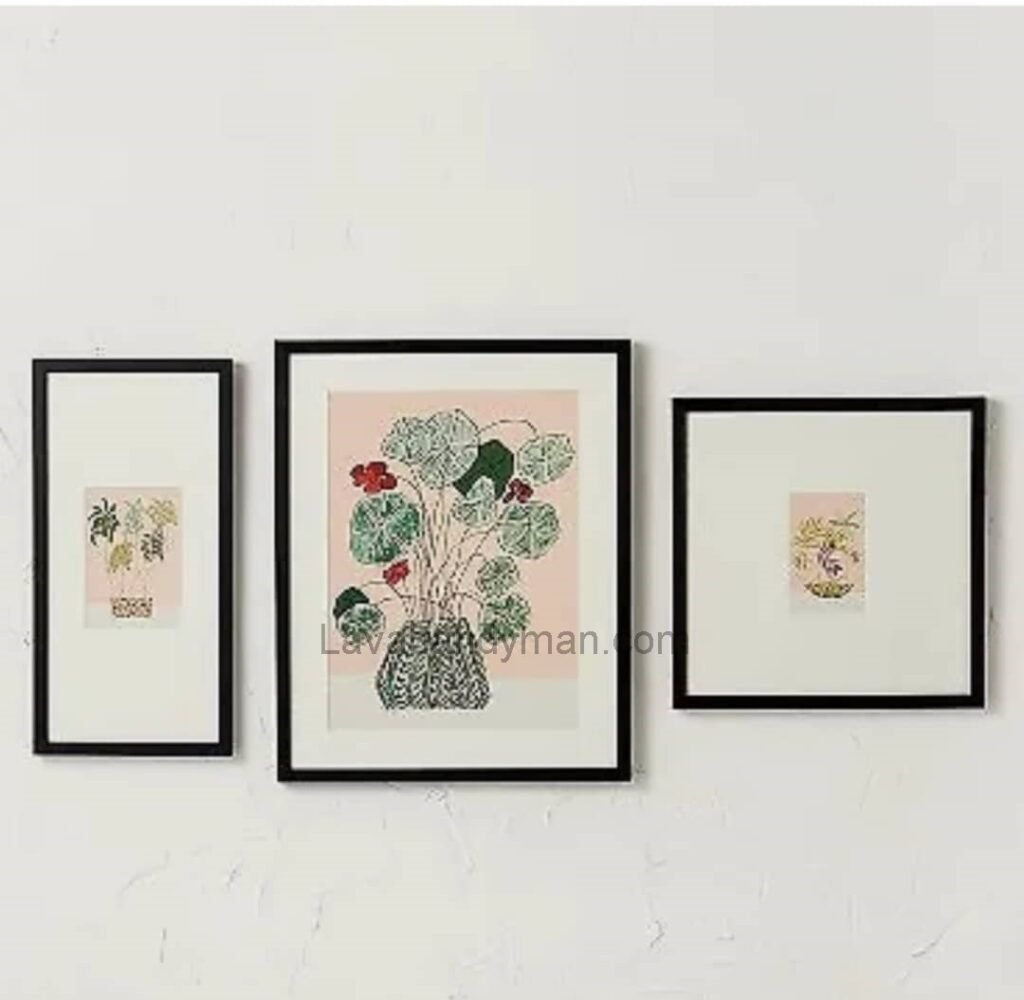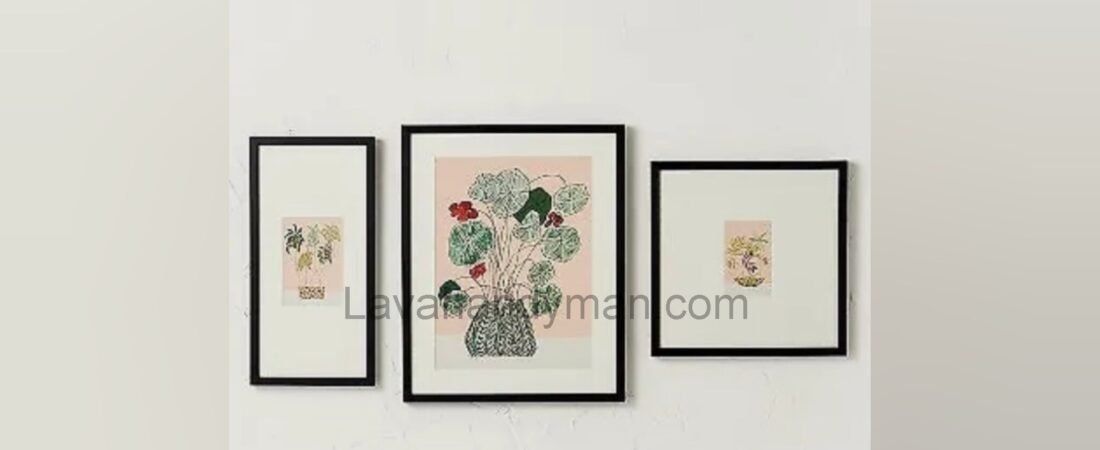How to Hang a Three-Piece Painting on the Wall
Introduction
Three-piece paintings, also known as Triptychs, are one of the most popular options for wall decoration. Hanging a three-piece painting not only enhances the beauty of a space but also adds a sense of order and harmony to the environment.
While hanging a single painting is relatively simple, installing a three-piece painting on the wall requires precision, the right tools, and attention to spacing and alignment. In this article, we will guide you step by step through the installation process, required tools, professional tips, and decorative ideas for three-piece paintings.
Choosing the Right Wall for a Three-Piece Painting

1. Check the Wall Size
The wall for a three-piece painting should be large enough to accommodate all three panels without looking cluttered. Living rooms, bedrooms, and office walls are ideal locations.
2. Proper Lighting
Natural light or soft lighting enhances the painting’s details and colors. Proper lighting ensures your triptych looks its best.
3. Wall Color and Texture
Light-colored and smooth walls are usually the best choice, as they highlight the painting and maintain visual harmony.
How to Hang a Three-Piece Painting on the Wall
Tools and Materials Needed to Hang a Three-Piece Painting
To hang your triptych professionally, you will need:
- A tape measure or long ruler for accurate measurements.
- A level to ensure straight and even installation.
- A pencil for marking positions.
- Screws and wall plugs for drywall or concrete walls.
- Nails or hanging hooks for wooden walls.
- Hammer or drill for installing plugs and nails.
- Painter’s tape (optional) to temporarily hold the panels.
Steps to Hang a Three-Piece Painting on the Wall
Step 1: Mark the Wall
Use a tape measure and pencil to find the center of the wall and determine the spacing between panels. Draw horizontal lines with a level to ensure the paintings are hung straight and evenly.
Step 2: Install Wall Plugs or Hooks
- For drywall or concrete, drill holes and insert wall plugs.
- For wooden walls, use nails or special painting hooks.
Step 3: Hang the Paintings
Start with the middle panel, then hang the two side panels according to the measured spacing. Use a level to ensure all panels are perfectly aligned.
Step 4: Final Adjustments
After hanging, double-check spacing and alignment and make any necessary adjustments.
Professional Tips for Hanging a Three-Piece Painting
- Height: The center of the painting should be around 140–150 cm (55–59 inches) from the floor for optimal viewing.
- Color Coordination: Ensure all panels have harmonious colors and designs.
- Temporary Template: Use paper or cardboard to visualize placement before permanent installation.
- Heavy Paintings: Use strong wall plugs and thick screws for heavier panels.
- Lighting: Wall lights or hidden lighting can enhance the visual appeal.
Decorative Ideas for a Three-Piece Painting
- Hang above a sofa or dining table to create a visual focal point.
- Combine with small picture frames or mirrors for added charm.
- Use modern or abstract paintings for a stylish and contemporary look.
Types of Brackets for Hanging Paintings: A Complete Guide for Triptych and Heavy Wall Art
When hanging paintings, especially three-piece paintings (triptychs) or heavy artworks, choosing the right bracket is essential. Using the proper bracket ensures the painting is securely mounted and prevents it from falling or getting damaged. Below, we review the most common types of brackets and their applications.
1. L-Bracket
- Shape: Resembles the letter L
- Use: Suitable for heavy paintings and large frames
- Installation: One side of the bracket is screwed into the wall, and the other side is attached to the frame
- Advantage: Supports heavy weight and prevents the painting from falling
- SEO Keywords: L-Bracket for painting, hanging heavy artwork
2. D-Ring Bracket
- Shape: Small metal ring attached to the painting frame
- Use: Suitable for medium and large paintings
- Installation: The ring is screwed into the frame and hung on the wall using a wire or hook
- Advantage: Easy to adjust height and level the painting
- SEO Keywords: D-Ring painting bracket, hanging painting on wall
3. Z-Hanger Bracket
- Shape: Resembles the letter Z with two edges that lock the frame to the wall
- Use: Ideal for heavy and large paintings, especially when the painting should sit close to the wall
- Advantage: Secure and hidden from view
- SEO Keywords: Z-Hanger for painting, hanging triptych
4. Cleat Bracket (French Cleat)
- Shape: Two pieces of wood or metal—one attached to the wall and the other to the frame
- Use: Heavy and large paintings, particularly triptychs
- Advantage: Quick installation, adjustable, and very secure
- SEO Keywords: Cleat for painting, secure hanging of heavy artwork

5. Simple Picture Hooks
- Use: Suitable for light to medium-weight paintings
- Advantage: Quick and easy installation
- Note: Not recommended for heavy paintings
- SEO Keywords: Picture hook, hanging light painting
Important Tips for Hanging Paintings with Brackets
For triptych paintings, make sure the spacing between panels is consistent.
Always choose a bracket appropriate for the weight of the painting.
For heavy paintings, Cleat or Z-Hanger brackets are recommended.
Use a level to ensure the painting is straight before installation.
Proper wall anchors increase stability and safety.
Step-by-Step Guide to Hanging a Three-Piece Painting on the Wall
Hanging a three-piece painting, or triptych, requires precision and the right tools to create a professional and visually appealing display on the wall. Below is a step-by-step guide with practical tips for installing your paintings.
Step 1: Choose the Right Wall for Your Triptych
- Select a wall with enough space so all three panels can be displayed without looking crowded.
- Walls with proper lighting and light colors work best.
- Living rooms, bedrooms, or office walls are ideal for triptych installations.
Step 2: Determine the Center and Hanging Height
- Measure and mark the center of the wall using a tape measure.
- The ideal height for the center of the painting is between 140–150 cm (55–59 inches) from the floor.
- Mark the center point with a pencil for easier alignment during installation.
Step 3: Measure the Distance Between Panels
- Maintain a spacing of 5–15 cm between each panel.
- Use a level to draw horizontal lines and ensure the panels are straight.
- For larger paintings, slightly larger spacing (10–15 cm) enhances the visual effect.
Step 4: Prepare Tools and Brackets
Essential tools and materials include:
- Level
- Tape measure and pencil
- Wall plugs and screws suitable for your wall
- Appropriate brackets or hooks (L-Bracket, D-Ring, Z-Hanger, Cleat)
- Drill or hammer
- Painter’s tape (optional for temporary placement)
Step 5: Install Wall Plugs or Hooks
- Mark the drill holes on the wall.
- For drywall or concrete walls, drill holes and insert wall plugs.
- For wooden walls, nails or hooks can be used directly.
Step 6: Hang the Paintings
- Start with the middle panel and ensure it is level.
- Hang the two side panels according to the measured spacing.
- Make sure all panels are aligned horizontally and level.
Step 7: Final Adjustments
- Double-check spacing and height of all panels.
- Make small adjustments if needed to ensure perfect alignment.
- Secure the paintings firmly to prevent wobbling or falling.
Step 8: Lighting and Completing the Decoration
- Installing wall lights or hidden lighting can enhance the painting’s appearance.
- Check the overall arrangement of the triptych with furniture and other decorative elements to ensure a cohesive look.
Professional Tips
Always use a level to make sure the paintings are perfectly straight.
Before permanent installation, use cardboard or paper templates to simulate the placement of the paintings.
For heavy paintings, always use strong brackets and appropriate wall anchors.
Final and Professional Tips for Hanging Paintings on the Wall
Hanging paintings, especially three-piece or heavy artworks, requires following professional tips to ensure that the artwork is securely and beautifully displayed on the wall, enhancing the overall decor of your home or office.
1. Choosing the Right Wall
- The wall should have enough space for a three-piece painting so the panels are displayed without crowding.
- Light-colored and simple walls provide the best background for paintings.
- Well-lit walls highlight the colors and details of the artwork.
2. Ideal Hanging Height
- The center of the painting should be 140–150 cm (55–59 inches) from the floor for natural eye-level viewing.
- For triptych paintings, all panels should be aligned horizontally and level.
3. Spacing Between Panels
- Maintain a spacing of 5–15 cm between each panel.
- Proper spacing ensures the painting is viewed as a cohesive piece while each panel remains individually visible.
4. Choosing the Right Tools and Brackets
- Select brackets or hooks appropriate for the weight of the painting: L-Bracket, D-Ring, Z-Hanger, Cleat.
- For heavy paintings, always use strong wall plugs and secure brackets.
- A level is essential for accurate and even installation.
5. Testing Before Final Installation
- Use cardboard or paper templates to simulate placement before permanent installation.
- This ensures the panels are evenly spaced and aligned correctly.
6. Painting Lighting
- Wall lights or hidden lighting enhance the painting’s colors and details.
- Proper lighting increases visual impact while protecting paint from direct exposure.
7. Safety and Stability
- Heavy paintings must be installed with sturdy brackets and secure screws.
- Ensure the artwork is level and firmly mounted to prevent wobbling or falling.
- Keep appropriate distance from wall edges and furniture to avoid accidental bumps.
8. Decorative Arrangement
Match the painting’s color and style with the overall room decor to increase harmony and elegance.
Triptych paintings look best above sofas, dining tables, or work desks to create a focal point.
Combining paintings with small frames, mirrors, or decorative items enhances the wall’s visual appeal.
Conclusion
Hanging a three-piece painting is a combination of art and precision. By choosing the right wall, measuring carefully, using proper tools, and maintaining correct spacing and height, you can create a professional and harmonious wall decoration.
📞 Need Help?
Let us take care of the hard work while you sit back and relax.
📍 Serving: Austin, Round Rock, Cedar Park & more
📱 Call or Text: (737) 420-6992
🌐 Visit: https://lavahandyman.com


